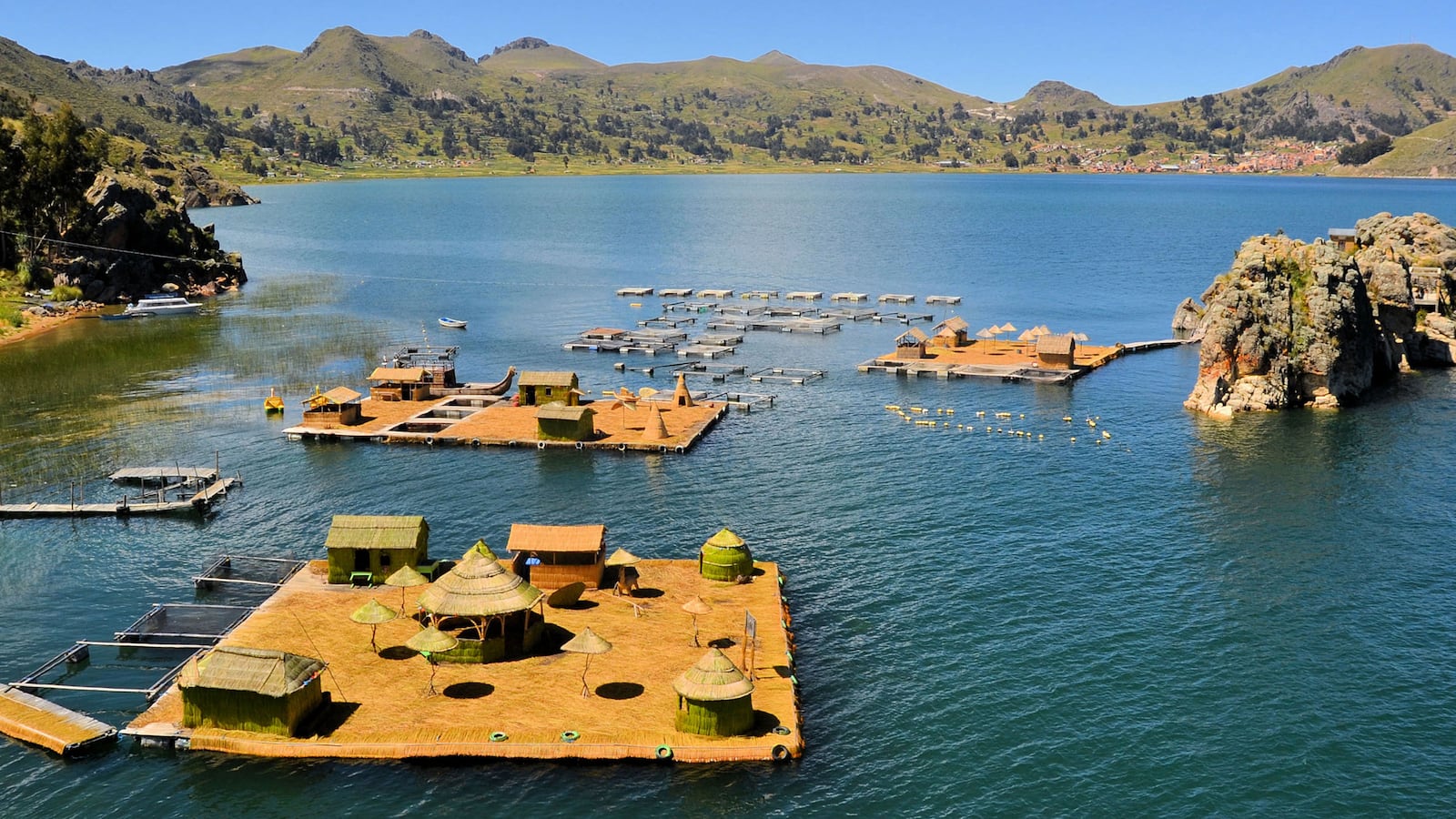“You can’t bring your wheelchair to Uros,” my guide told me. He pointed to a collapsible and slightly dilapidated manual wheelchair nearly a foot too wide for me. “Use this one.”
I had just arrived in Puno, Peru, to see the floating Uros islands on Lake Titicaca, the 120-mile long lake that sits between Peru and Bolivia. To get there, I had flown to Lima and then the southwestern desert town of Arequipa, before driving southeast through Colca Canyon across the Andes mountains in a van. At each stop we made, my guides had said the same thing—my 200-pound electric wheelchair would not be able to get around whatever we were seeing that day. But besides a monastery in Arequipa that was almost all stairs and Machu Picchu, my guides had mostly been wrong.
I like to think of my wheelchair as the Little Engine that Could. It has taken me over glaciers in Iceland and across the sand and stone of Petra’s ancient canyon, through ancient jungle temples in Bali and over miles of cobblestone streets all over Europe. But something in my guide Alex’s concerned face told me to go with it. In the loaned manual wheelchair, Alex, his friend Max, who came along for his strength, and I, boarded a small boat in Puno’s harbor. As Max lifted me and then the loaner chair into the boat, I was already glad I had taken it instead.

Out on the water, it felt like I was taking the first proper breath I’d had in days. Lake Titicaca is the highest navigable body of water in the world at nearly 13,000 feet in elevation, but it was still a lower altitude than most of the route I’d taken to get there. During that drive, I had learned altitude sickness is not a joke. Any time we went over 14,000 feet, I got nauseated and my heart raced. It felt like I was suffocating whenever I tried to lay down, and the adrenaline from my racing heart made it impossible to sleep. I had been living on coca tea—the main ingredient in cocaine that’s completely harmless and an altitude sickness lifesaver in its plant-based form.
The first sign we had reached Uros was a small island with a single reed hut and a lookout post about four miles away from the coast of Puno, almost to Bolivia. It was impressive on its own, but just beyond that, the water suddenly opened up to a colorful and vibrant village floating in the middle of the lake on nothing but layers of thin green totora reeds and blocks of mud. The totora reed grows almost exclusively on Lake Titicaca and Easter Island in Chile, and can reach up to twenty feet high.

The people of Peru are masters of their environment. Each mountain in Colca Canyon is lined with stone terraces built by the Incas centuries ago, from the base to the peak. Peruvians still use these terraces every day, climbing hundreds of feet to farm everything from potatoes to quinoa.
The islands of Uros are an equally ingenious feat of physics and ingenuity. The indigenous people of Uros have harnessed the power of the totora reed and have been living on the islands for centuries. There are over 100 islands in Uros, each one no more than 90 feet wide and four to eight feet thick. They use large hand saws to cut out three-foot thick bricks of the mud and roots underneath to reeds in the shallow parts of the lake. They bind these bricks together to form the base of the islands and layer the totora reed on top to give the islands their buoyancy.
Each island can house up to 10 families and are tethered together by rope so they do not drift apart and anchored by eucalyptus tree trunks. There are no walls on the islands except for the reed ones that make up the peoples’ homes, and nothing to stop you from dropping over the edge into the water. Even though Lake Titicaca has an average depth of around 440 feet, many of the Uros people do not know how to swim.

For the Uros people, the totora reed is at the very center of their lives. Not only does the reed keep them afloat, they also use it to build their boats, homes, and the handicrafts they sell to tourists, as well as for medicine and food. The islands are in a constant state of decay, and so every day the people must cut reeds from the shallower parts of the lake where they grow and spread them out over their islands.
From certain angles, the islands simply looked like extensions of the shoreline. Then we stepped onto one of them and our feet and wheels quickly sunk down several inches into the dried reeds. It was like trying to move on top of a spongey mattress. Max had to pull the wheelchair like a cart and at one point, a bundle of reeds got caught in the undercarriage. I panicked at the idea that I was tearing up the only thing keeping families from dropping into the water. But Max just scooped the pile of reeds out from under the chair and laid them back out on the island floor.

The lake was calm and the sky blue that day but the islands still bobbed and swayed with the water, creating this sense that the islands were alive. Every slosh and bob was a breath. It made me wonder, though, what it would be like to be here during high wind or a storm.
The boats transporting tourists alternate between islands so that each family has an opportunity to make money. My boat took us to the island with the local Uros kindergarten and the home of the school’s founder and teacher, Amalia Suana. It was a lucky day, Alex said, Amalia’s island was his favorite. No matter what country I’m in, my wheelchair is always of some interest as I travel and I wondered what Amalia and her family would think about it. Amalia and her family welcomed us with bright smiles, appearing not to even notice the chair. Instead, she invited me to come sit in her home—a one room reed house with a bed made of reeds. They gave me a demonstration on how they build their islands using the totora reeds.

Uros is home to some of the starkest poverty in Peru and Amalia grew up on the islands without ever having the opportunity to go to school. As a young adult, she saved money by selling handicrafts to pay her way through college on the mainland to become a teacher. She returned to Uros with a teaching degree and created the first kindergarten on Uros without the help of government funding, despite requests for aid. Later, Amalia received an international award for her work and the Peruvian government began funding the school, but the school still relies on donations from visitors to buy supplies and books for the children.
The handicrafts made by the people of Uros were the most beautiful I found in all of Peru. The women stitch beautiful scenes on blankets with colorful thread and fabric completely from memory and without a pattern, while the men make hanging mobiles, toys, instruments, and ornaments out of reeds and gourds. The clothes the people of Uros wear are equally vibrant, with patterns of flowers and geometric designs stitched in by hand. Many of the women attach large hot pink or lime-colored yarn pompoms to the end of their long braids.

Uros is still a bit of a mystery. The people descend from the Uru, one of the most ancient people in the Americas. They created the islands to escape violence on the mainland while the Incas were expanding their territory centuries ago, but no one really knows how long the people have been there. Bobbing along on Lake Titicaca, it was easy to see why the people of Uros picked this place as their escape. It felt like the edge of the world. But even on the edge of the world, I discovered that technology had found a way in. The reed boats are mostly for tourists, as most of the islanders use small motorboats. Several portable solar panels pop up above the homes, a recent addition to the island after a former Peruvian president stayed the night on the islands and wanted to be able to read in his bed in the evening. On one of the other islands, there is also a small convenience store where you can buy American candy bars and sodas, as well as fried quinoa bread and the locally popular neon yellow Inca Cola. The soda tastes like bubblegum but is still somehow delicious, and it certainly provides a more authentic Peruvian experience. You can also rent kayaks to paddle around the islands on your own.
Most people go to Peru for Machu Picchu and to marvel at the ingenuity of the Incas. However, only 250 miles away bobbing and swaying on the world’s highest navigable lake, sits a living example of the region’s resourceful people that remains almost unchanged by time.
Cindy Otis worked for the CIA for 10 years as a military analyst and a Branch Chief, specializing primarily in Europe and the Middle East. She is now a writer and consultant. Follow her on Instagram at @cindyotis_






